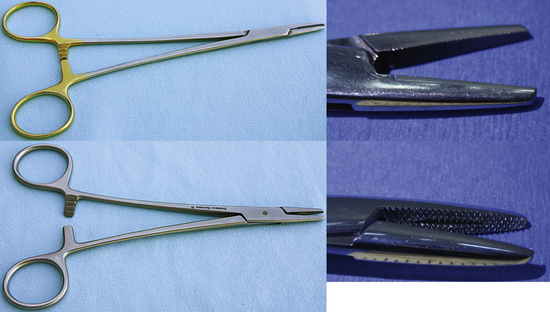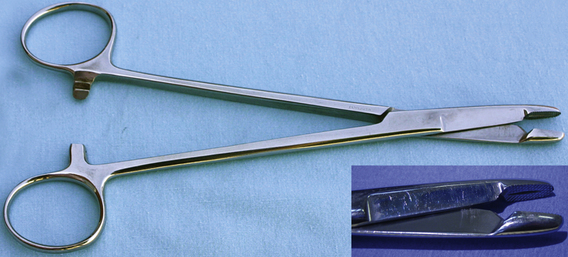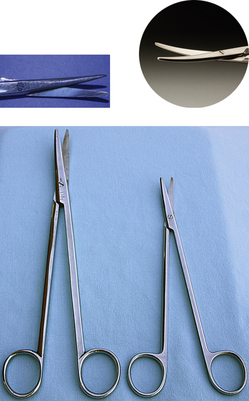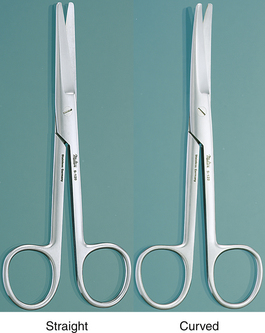CHAPTER 16 Needle Holders and Scissors
The needle holders are used to place sutures; the scissors are used to cut tissue, suture material, bandaging material, and other items.
INSTRUMENT
Mayo-Hegar Needle Holder
| FUNCTION | To drive suture needles through tissue that requires suturing and to assist in tying sutures. |
| COMMON NAME | Needle Holder |
| CHARACTERISTICS | Short jaws have grooves that are cross hatched on the surface, and some models have a longitudinal groove down the centers of the jaws. The cross-hatching provides superior holding power so the needle does not turn in the jaws. The needle holder has a box lock and may have carbide inserts in the jaws. The inserts can be replaced if the jaws lose their gripping power, thus extending the life of the needle holder. Needle holders with carbide jaws have gold handles. Lengths include 5¼, 6, 7, 8, 10½, and 12 inches. The size of the needle holder is determined by the size of the needle used. A needle that is too large for a particular needle holder can damage the jaws and the box lock. |
INSTRUMENT
Olson-Hegar Needle Holder–Scissors Combination
| FUNCTION | To drive suture needles through tissue that requires suturing and to assist in tying sutures. |
| COMMON NAME | Needle Holder |
| CHARACTERISTICS | Scissor blades are set behind the jaws. After the suture is tied into a knot, the surgeon can cut the suture material with the same instrument. This can speed up the time it takes to suture, but a false move can mean disaster, for it is possible that the surgeon might cut the suture material in the wrong place or inadvertently cut tissue. The lengths of this instrument may be 5½, 6½, or 7½ inches. They too are available with carbide jaws. |
INSTRUMENT
Metzenbaum Scissors
| FUNCTION | To blunt-dissect or cut soft tissues. |
| CHARACTERISTICS | The fine blades on this scissors are approximately 1½ inches long and have blunt or pointed tips. Their lengths can be 4½, 5¾, or 7 to 11 inches, but the most common length is 7 inches. The blades can be straight or curved, smooth or serrated. This scissors should never be used to cut suture material or bandaging material because doing so dulls the blades. (Blunt dissection involves introducing the closed blades into an area; the blades are then opened and pulled backward through the tissues.) Blunt dissection stretches the small capillaries so they do not bleed, and it prevents the accidental cutting of tendons, ligaments, and large blood vessels. |
< div class='tao-gold-member'>
Only gold members can continue reading. Log In or Register to continue
Stay updated, free articles. Join our Telegram channel

Full access? Get Clinical Tree






